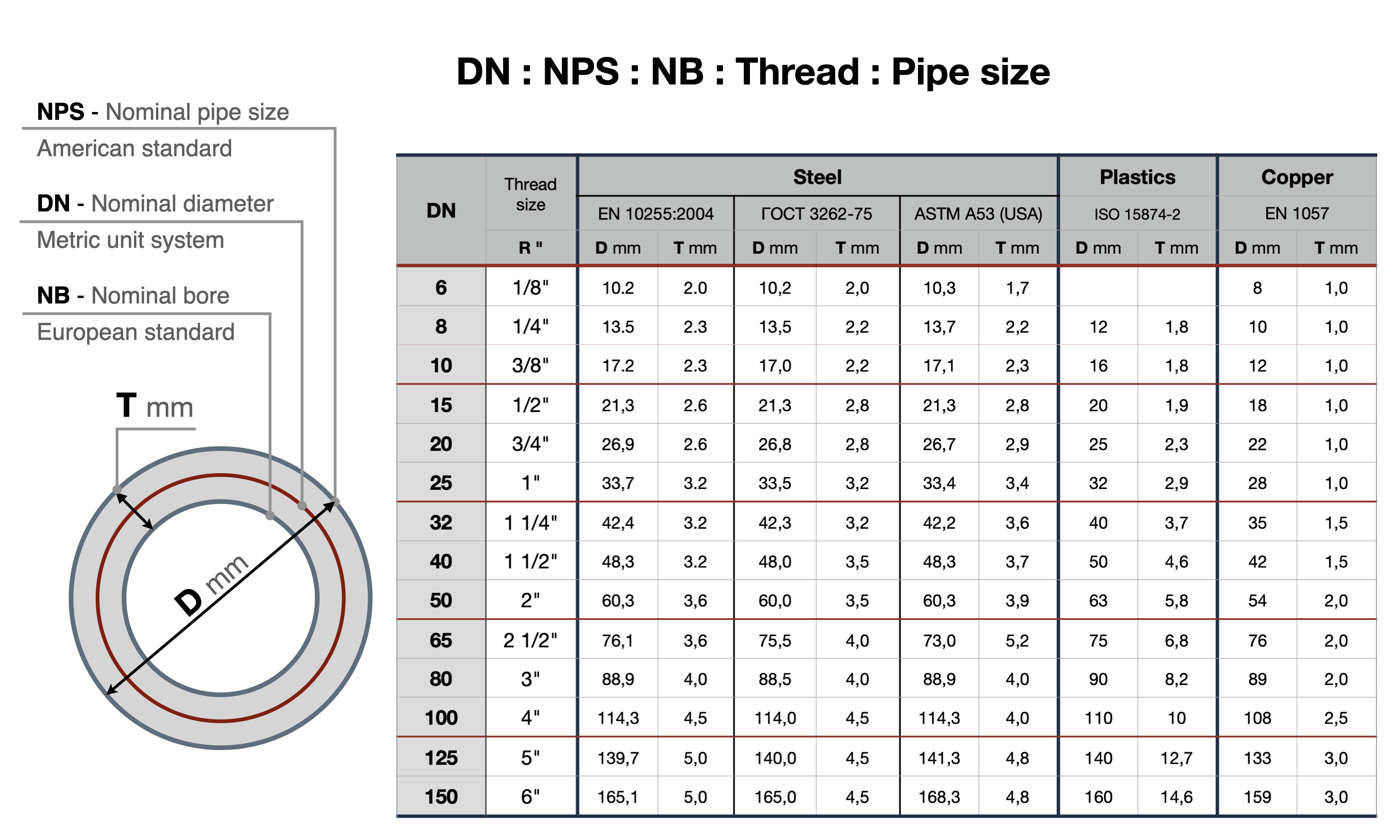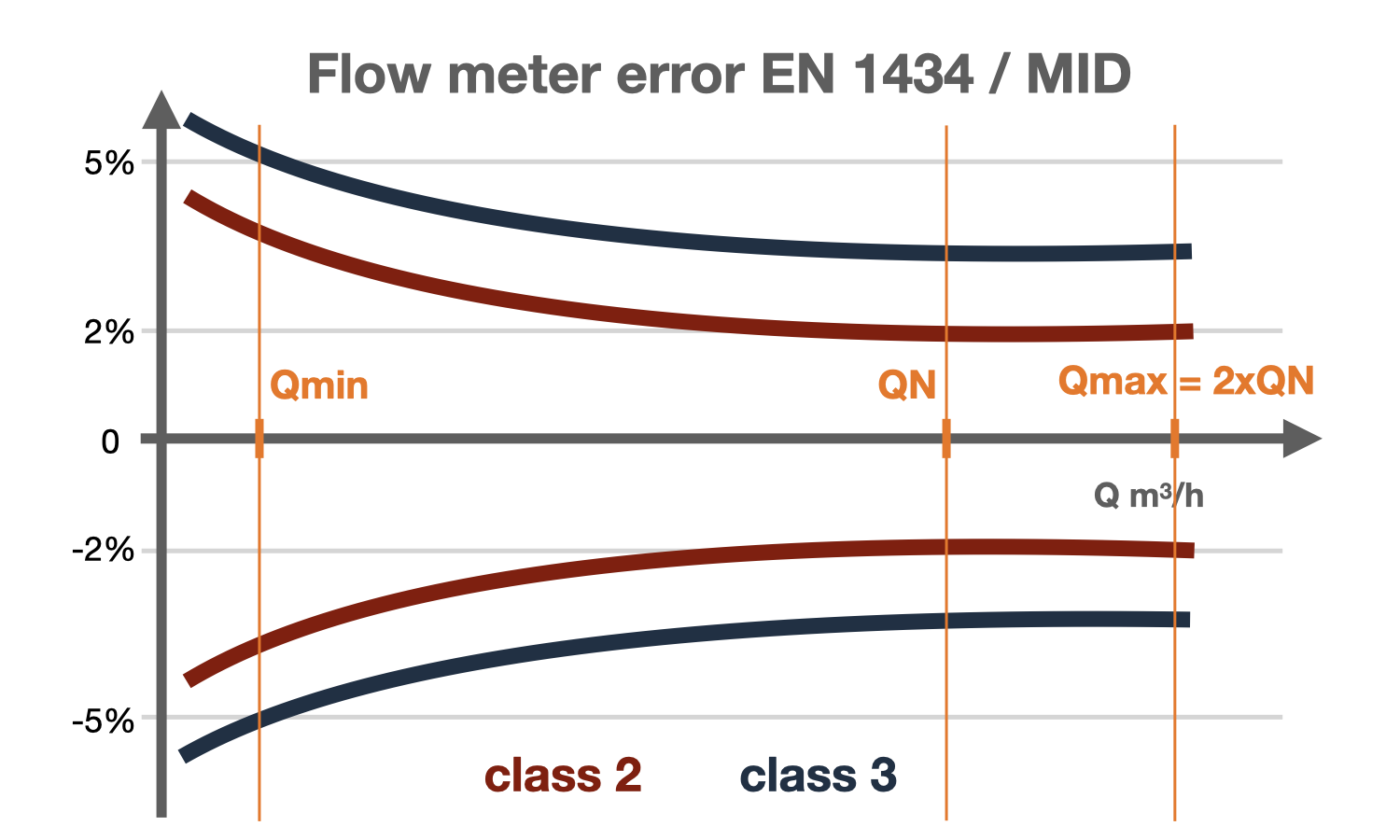Please do not block ads on our site. Clicks on ads help us exist, grow and become more useful for you!
Technical specifications of heat meters
DN of the heat meter - this is the nominal diameter of the openings in the connecting pipes. The value of DN is used to standardize the dimensions of pipeline fittings. The actual diameter of the opening may be slightly larger or smaller.
Interestingly, in the case of a threaded connection to the pipeline, the actual diameter of the thread on the flowmeter of the heat meter is always one size larger than the nominal diameter. This is because the heat meter must be installed with connecting fittings. So, the external thread of the connecting fitting corresponds to the DN of the meter, while the internal thread of the nut, which connects to the flow meter, is one size larger than DN.
PN of the heat meter - this is the nominal pressure, which is the maximum excess pressure of the working medium with a temperature of 20°C, at which long and safe operation is ensured.
Heat meter accuracy class
The limits of permissible relative error (when calculating the amount of heat consumed), depending on the temperature difference, should not exceed the values given in the table.
Note: the error values corresponding to the flow rate in the range from Qmin to Qt are given in parentheses.
| Temperature difference (°C) |
Class 2 | Class 2.5 | Class 4 | Class 5 |
|---|---|---|---|---|
| dTmin < dT < 10 10 < dT < 20 20 < dT < dTmax |
+/-4% +/-3% +/-2% |
+/-5,5%(+/-7,5%) +/-3,5%(+/-5,5%) +/-2,5%(+/-4,5%) |
+/-6%(+/-8%) +/-5%(+/-7%) +/-4%(+/-6%) |
+/-8%(+/-10%) +/-7%(+/-9%) +/-5%(+/-7%) |
Allowable error limits for flow meters
Class 1 — E=+/-(1 + 0.01 QN/Q), but no more than +/-5%.
Note: The formula provides an approximate value of the allowable error. The allowable error limits for flow meters of the first class will be determined when the improvement of flow meter testing methods allows it.
Class 2 — E=+/-(2 + 0.02 QN/Q), but no more than +/-5%
Class 3 — E=+/-(3 + 0.05 QN/Q), but no more than +/-5%
where Q is the actual flow rate of the heat transfer medium.
Allowable Flow Range
Qmax (qs) maximum flow rate — the highest flow rate at which the heat meter should operate for a short period of time (less than 1 hour per day and less than 200 hours per year) without exceeding its maximum allowable error.
QN (qp) nominal flow rate (continuous flow rate) — the highest flow rate at which the heat meter should operate for an extended period of time without exceeding its maximum allowable error.
Qmin (qi) minimum flow rate — the lowest flow rate above which the heat meter should operate without exceeding its maximum allowable error.
Dynamic Range — the ratio of QN/Qmin should be 10, 25, 50, 100, or 250.
Allowable Temperature Range
Maximum allowable temperature — the maximum temperature of the heat transfer medium at which the heat meter can operate for short periods of time (less than 200 hours over the entire service life) under maximum allowable working pressure and nominal flow rate without significant malfunction after being exposed to that temperature.
Tmax maximum temperature — the highest temperature of the heat transfer medium at which the heat meter operates and its error is within allowable error limits.
Tmin minimum temperature — the lowest temperature of the heat transfer medium at which the heat meter operates and its error is within allowable error limits.
dTmax maximum temperature difference — the highest temperature difference at which the heat meter should operate at a heat flow not exceeding the maximum value and its error is within allowable error limits.
dTmin minimum temperature difference — the smallest temperature difference above which the heat meter should operate and its error is within allowable error limits.
question : comment : feedback
419
 Catalog of
Catalog of heat meters
Landis Gyr
Landis Gyr
DIEHL
Zenner
Zenner
AXIOMA Metering
AXIOMA Metering
Аква Украина
Kamstrup
Kamstrup
Engelmann
Sensus
Sensus
Itron
Maddalena
ИТ
Семпал
Семпал
Sontex
Danfoss
Danfoss
Danfoss
Kamstrup
Kamstrup
Kamstrup
Sontex
Sontex
Sontex
Sontex
DIEHL
DIEHL
Sensus
Sensus
Sensus
Sensus
Sensus











 EN 1092-1
EN 1092-1
